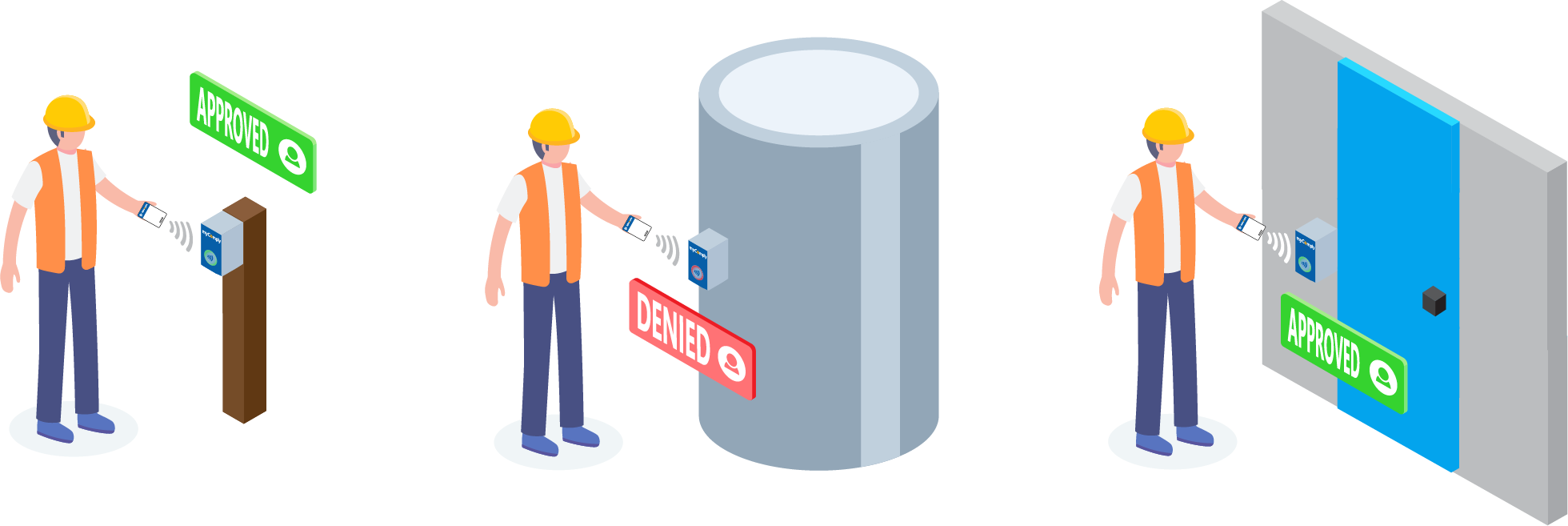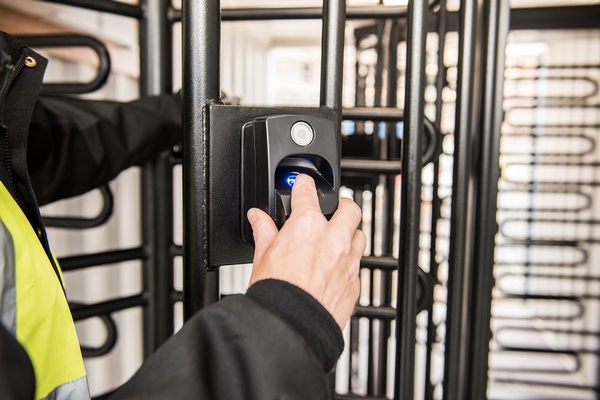Access control in construction is essential in promoting safe and secure project sites. Project owners, general contractors (GCs), and construction managers (CMs) cannot afford to have unauthorized foot traffic on their sites at any time.
Without proper countermeasures in-place, these stakeholders risk the following:
- Workers with expired certifications might gain access to a project site and increase the risk of non-compliance related fines.
- Workers might bypass site orientations and increase the risk of incident on the project. Incidents lead to lost time, lawsuits, and (at worst), can lead to workers not making it home to their families.
- Theft, loss, and vandalism, stemming from unwanted civilian traffic or opportunistic vandals and thieves.
Fortunately, modern construction access control systems allow these stakeholders to mitigate most (if not all) of the risk associated with unauthorized site access.
This article will explore what access control in construction means, the components of physical access control systems, as well as the leading categories of access control being used in construction today.
Table of Contents
What is Construction Access Control?
Access control
Logical access control
Physical access control
Access control in construction
The Components of Physical Access Control in Construction
Access point(s)
Personal credentials
Readers and/or keypads
Control panel
On-premises servers
Cloud-based platform
3 Types of Physical Access Control in Construction
1. On-Site Security
2. Biometric Access Control
3. Attribute-Based Access Control
Conclusion
What is Access Control in Construction?
The term “access control” can be ambiguous, as it can pertain to lock-and-key doorways for personal or commercial use, while also pertaining to authentication and security parameters on software and hardware applications. Here is a breakdown of the definitions of access control, logical access control, physical access control, and access control in construction, as well as how they differ from each other.
Access control
Access control is a selective restriction of access to a given asset, be that information or a physical asset. Security of the asset is then guaranteed through an authorization process which grants access to only those who have necessary permissions to interact with the asset.
Logical access control
Logical access control pertains directly to access control systems which require information or intellectual property to grant access, such as a code, a pin, a password, or otherwise. These controls are used to secure digital connections, files, or cloud access.
Physical access control
Physical access control mechanisms are those which require card, fob, or a unique personal identifier (such as a retinal scan) to grant access. These controls are used to protect physical property, be that rooms, buildings, grounds, or otherwise.
Access control in construction
The simultaneous security of both information and physical access to a project site. This is achieved through a combination of software and hardware. Hardware components, such as cards, badges, or fobs, will interact with other smart hardware (magnetic locks, card readers, etc.), to confirm identity or qualification, and grant physical access based on specified requirements.
Read our full article on construction access control to find out more!
The Components of Physical Access Control in Construction
Though it often seems like a straightforward process, most access control systems are quite complex. Here are the key components in some or most physical access control systems that are used in the construction space.
Access point(s)
The location(s) where workers gain access to project sites. In construction, these points are secured via gates, door locks, or turnstiles. The fewer the access points, the more secure the project site.

Personal credentials
Not all physical access control systems in construction are equipped with personal identifier tracking. Some are simply lock-and-key, without any individual identification mechanisms. However, those that track personal credentials do so via encrypted badges, mobile devices, smart devices with near-field communications (NFC) or radio frequency identification (RFID) technology, or coded cards/fobs.
Readers and/or keypads
The “lock” in the access control relationship. All personal credentials, no matter the medium, need to be verified via some type of reader. Most of these readers are enabled with NFC or RFID technology, which can then communicate with the “keys,” be them personalized or not. These readers will either relay information to a control panel to determine if access requirements are met, or if it is a smart reader, it passes information on to a cloud-based platform to verify credentials.

Control panel
A control panel is a piece of hardware that is connected to more basic readers or keypads. This hardware uses a yes/no criterion to permit access (ex. is this an active and valid key fob).
On-premises servers
On premise servers are small data centers where access control information can be stored. On-premises servers are common in fixed access control units with high security requirements. Server applications are less efficient in the construction sector where most access points are only utilized for the duration of the project.
Cloud-based platform
If you are using a smart access control technology, then either your reader or control panel will be connected to a cloud-based platform. Oftentimes, this is a one-way relationship, where readers and control panels simply share information to the cloud. However, some access control technologies communicate both ways with readers or control panels.
3 Types of Physical Access Control in Construction
Some of the construction-specific access control formats were hinted at above, but there are three very distinct categories when it comes to using access control on modern construction sites.
1. On-Site Security
Though this type of access control does not include any of the technological components outlined above, it is the original access control system, and may warrant some consideration. Factors such as the location of your project site and the size of your project site may make hiring an on-site security team a viable option for you.
Some of the key benefits to on-site security include:
- Increased deterrence. With all the technology available, the fact remains: a physical security presence often deters more negligent or criminal behavior than a technological solution.
- Team morale. A software enabled turnstile is not going to greet your team with a smile and a cheesy joke when they enter a project site.
However, some of the drawbacks include:
- Depending on the size of your project and the risk of interference, paying salaries for a security team can become a major cost bucket that could be avoided with the right physical access control system.
- Limited personal credential monitoring. Outside of manual personnel recognition efforts, a security team can do little to confirm that all workers have the necessary certifications to be conducting work on a project site.
- It can be difficult for a security team to constantly monitor every square foot of a construction site.
Top Solutions for On-Site Security
American Protection Group is one of the leading security contractors in the United States with a specialization in construction site access control. However, there are other security groups such as GardaWorld, Fast Guard, and On Guard Security, which may also make great options, depending on the scope of your project.
2. Biometric Access Control
Biometric authorization for construction access control is one of the most innovative answers to the problem of site security.
These technologies leverage some form of biometric reader or scanning device that assesses a worker’s physical attributes to determine whether they have permission to enter a project site. This is effective as it eliminates much of the human error that is associated with human access control mechanisms, such as on-site security teams.
The most frequented bio-indicator on these access control systems is the fingerprint, as shown below:
Source: Planet Biometrics
However, some of the greatest obstacles with using biometrics to secure construction sites include:
- Expect biometric solutions like fingerprint scanners and facial recognition software to cost 10x more than competing solutions.
- Like our smart phones, most biometric access control systems are imperfect. They make mistakes and have the potential to permit access to unauthorized personnel or deny access to authorized personnel. This can create headache inducing work for administrators and other on-site staff.
- Adding new workers or project guests to your access control system can be complicated and time consuming for site security staff, administrators, project managers, or whomever is responsible for updating the system.
Though these solutions are not a best fit for all projects, look for improved efficiencies and cost reductions over the coming years as these technologies continue to advance and economies of scale are achieved.
Top Solutions for Biometric Access Control
For facial recognition and heat sensing biometric access control, Data Scope has one of the leading solutions in the construction space.
For fingerprint scanners, Borer offers a solution with turnstile and magnetic lock integrations.
3. Attribute-Based Access Control
In information systems, attribute-based access control grants authorization on a variety of potential key attributes, such as subjects, resources, actions, and environments. Similarly, in the case of construction access control, attributes such as completed site orientations, valid certifications, and owner/GC permissions can be set and used to regulate site access.
For example, you might be employing several laborer’s on a given jobsite. Depending on the scope of the project and the state of residence, these laborer’s might need to have their fall arrest, first aid, OSHA 10, and OSHA 30. You do not want them to enter your project site if any of these certifications are expired, as this opens the door to non-compliance related fines and potential lawsuits in the case of incident.
Attribute-based access control systems mitigate this risk by setting necessary minimum criterion in which workers must meet to be granted access to a site. Here is how it works:
- A badge, decal, or other personal identifier is scanned against a card reader using NFC or RFID technologies.
- The card reader is connected to a wireless or mobile network, which it uses to send a request to a cloud-based database.
- The worker profile is found and scanned for necessary entrance requirements.
- The results of this scan are sent back to the reader which will approve or deny site access based on the results of the data requisition.
And all of this happens in a tenth of a second. The result? A worker like Adam would be denied access to a project site on account of outdated OSHA 30 training.
![]()
Source: Projects Pro
Top Solutions for Attribute-Based Access Control
myComply is the leading solution for attribute-based access control in the construction sector. myComply’s Projects Pro platform enables GCs and CMs to ensure 100% compliance on their projects by securing their access points with gateway connected Smart Bricks and allowing GCs and CMs to issue Smart Badges or decals which workers then use to request site access. Together, these hardware and software solutions form a comprehensive Construction Site Access Control system.
Interested in learning more? Book a discovery call with one of our product experts today!
Conclusion
Construction access control systems were popularized for use on mega projects in busy urban settings (such as New York City), but they are increasingly being deployed on projects of all shapes and sizes. This is due to their potential to provide project owners and GCs with greater project insights and insurance reductions, while also taking a proactive approach to improving quality of work and site safety on construction projects.





This one is the best! Keep posting like this!
Thank you for sharing your blog, seems to be useful information can’t wait to dig deep!